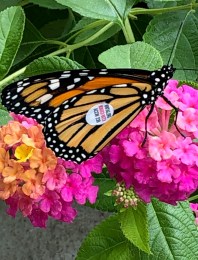How do you track a butterfly that travels thousands of miles each year migrating between the northern United States and Mexico?
If you are part of Project Monarch Watch, you tag them with tiny stickers that are placed, oh so carefully, on their hind wings so their flight is not inhibited.

The Oglebay Good Zoo in Wheeling, W.V., is tagging the monarchs before they fly south on their fall migration. The butterflies picked a great place to start their journey.

With help from Williams, the zoo this year installed a half-acre pollination station to attract butterflies, bees and hummingbirds. The pollinator garden provides two species of milkweed, on which the monarchs lay their eggs. The larvae feed on the leaves before they turn into butterflies.
“We tag the individuals that we raise as part of the University of Kansas Monarch Watch program,” said zoo director Joe Greathouse. “Each tag has an individual number associated with the location where the monarch was tagged. Researchers can then determine the origin of individuals arriving at overwintering sites as well as the pace of their migration and mortality rates experienced during migration.”
Populations of the monarch butterfly have declined greatly over the past 20 years, he said. These declines have been associated with the loss of milkweed across the species’ breeding range.
The pollinator garden also includes 10 other plant species that produce host plants or nectar for many types of butterflies, along with hummingbirds and honeybees.
Want to start your own pollinator garden? Here are some tips from Greathouse.
- Select pollinator and host species that are native to your region. Some of the best choices for planting a pollinator garden in the fall include Boltonia, Culver’s root, common boneset, and various aster species.
- Pick a space for the garden that considers competition from other plants such as trees and shrubs, and the amount of sunlight and moisture present in your site.
- Next, remove the existing vegetation and till the soil to prepare the seed bed. Add organic material such as compost.
Finally, plant the seeds and live plants. Regular watering, mulching and weeding will help your garden grow successfully.
